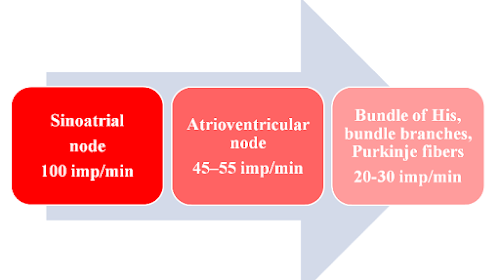Conducting system of the heart
Cardiac muscle cells contract without nervous stimulation. Pacemaker cells of conduction system spontaneously generate action potentials, which spread through gap junctions.
The conducting system
The sinoatrial (SA) node is the normal pacemaker of the heart and the origin of each normal heartbeat. The SA node is a collection of specialized myocytes near the site where the superior vena cava enters in the wall of the right atrium. Spontaneous depolarization of the SA node occurs, resulting in the generation of action potentials. Action potentials from the SA node spread rapidly throughout the atria via gap junctions between adjacent myocytes.
The atrioventricular (AV) node is the only electrical communication between the atria and the ventricles. It is characterized by very slow electrical conduction, ensuring that atrial contraction is completed before the ventricles are activated. The AV node is continuous with the ventricular conducting system.
The ventricular conducting system consists of the atrioventricular bundle (bundle of His), the left and right bundle branches, and the Purkinje fiber system. Action potentials spread rapidly through the ventricular muscle via gap junctions between the adjacent myocytes.
SA and AV nodal cells are pacemakers because their membrane potential difference depolarizes spontaneously, which is called the pacemaker potential or diastolic depolarization.
The maximum membrane potential difference in pacemaker cells is about -60 mV, but there is no stable period of resting membrane potential. During diastole in cardiomyocytes metabolic processes occur that cause the opening of sodium and calcium channels. It starts diastolic depolarization. When the pacemaker potential reaches a threshold voltage of about -40 mV, the action potential is triggered in the cells of the SA node.
Nodal (SA or AV) action potential
Phase 4 = unstable pacemaker potential;
phase 0 = slow depolarization upon stimulation;
phase 3 = repolarization.
Hierarchy of pacemakers:
The SA node is the normal pacemaker of the heart because it has the most rapid rate of depolarization. A person is in normal sinus rhythm when cardiac excitation progresses from the SA node through the entire conduction pathway.
The intrinsic rate of SA node firing is about 100 beats/min. Normal parasympathetic tone reduces the SA node firing rate to about 70 beats/min at rest.
The AV node becomes the pacemaker if the SA node fails or transmission to the AV node fails (assimilation of the rhythm) .




